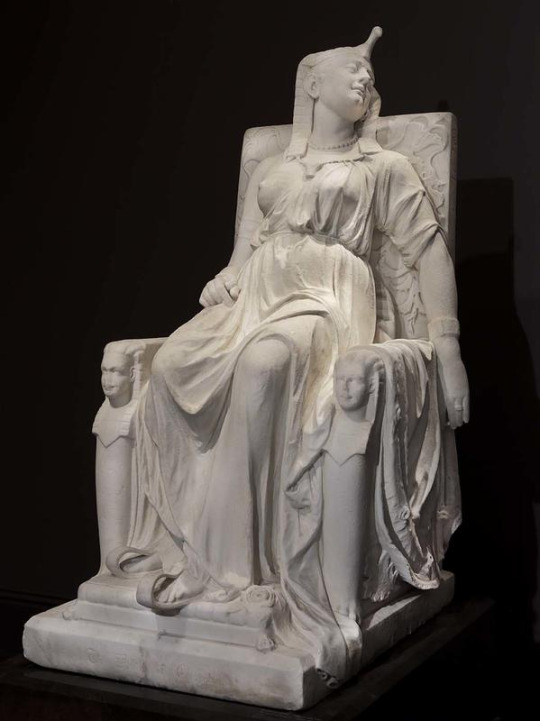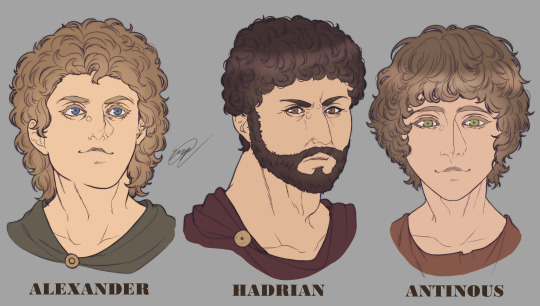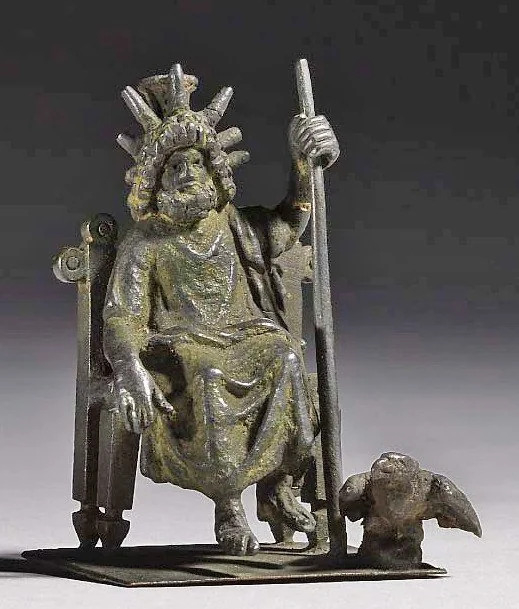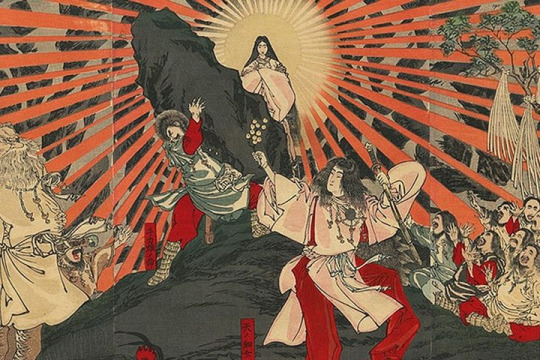#hellenistic egypt
Explore tagged Tumblr posts
Text
The Death of Cleopatra


Edmonia Lewis The Death of Cleopatra, 1876. Smithsonian American Art Museum, Gift of the Historical Society of Forest Park, Illinois.

Edmonia Lewis (1844-1907) was Black American sculptor.
2K notes
·
View notes
Text

Gold ring inset with carnelian intaglio representing Tyche
Hellenistic Period, possibly from Ptolemaic Egypt, 225-175 B.C.
J. Paul Getty Museum
#ancient art#ancient jewelry#Tyche#Fortuna#Hellenistic Egypt#cornucopia#Hellenistic Period#Greek#J. Paul Getty Museum#Getty Museum#gold#ring#intaglio#carnelian
393 notes
·
View notes
Text

Sardonyx cameo of Cleopatra VII depicted as Isis and Mark Antony as Osiris.
The image and description comes from the book called Engraved Gems which can be read for free here.
#cleopatra#cleopatra vii#mark antony#marcus antonius#roman history#ancient culture#ancient rome#cameo#ancient art#engraved gem#ancient egypt#hellenistic egypt#ptolemaic egypt
165 notes
·
View notes
Text



(Full view plz)
Some historical characters that will be making an appearance in the webcomic I'm developing!
#webcomic#ancient history#ramesses ii#hatshepsut#amasis#mark antony#cleopatra vii#octavian#augustus#alexander the great#hadrian#antinous#ancient egypt#ancient rome#ancient greece#roman egypt#hellenistic egypt#imperial rome#hellenistic period#republican rome#ptolemaic egypt#shmswart#thefollowersart
144 notes
·
View notes
Text

Statue (dolomitic limestone) of a Ptolemaic queen bearing a "Cleopatra" cartouche, perhaps representing Cleopatra VII (r. 51-30 BCE). Now in the Metropolitan Museum of Art.
#classics#tagamemnon#ancient history#Hellenistic period#Egypt#Ancient Egypt#Ptolemaic Egypt#Hellenistic Egypt#Cleopatra#Cleopatra VII#art#art history#ancient art#Egyptian art#Ancient Egyptian art#Hellenistic art#Greco-Egyptian art#Ptolemaic art#sculpture#portrait sculpture#statue#limestone#stonework#carving#cartouche#Metropolitan Museum of Art
171 notes
·
View notes
Text
There’s a Cleopatra movie in the works and we once again won’t get a historically accurate depiction. 😩
Contemporary busts from her time depicting what she looked like. ⬇️



I just want accuracy, man. That’s it. 😭 We could’ve got an actual Greek or Mediterranean person. :/
#cleopatra#rant about historical accuracy#JUST GET IT RIGHT GODDAMIT#look to history and not falsified crap#ancient history#ptolemaic egypt#hellenistic egypt#ancient egypt#history
8 notes
·
View notes
Text
A view to a solar non-dualism
During my study of the Greek Magical Papyri, a while back I encountered a phrase at the end of PGM IV. 1596-1715, which is a spell for Helios. The last line of the papyrus says that, when the consecration is complete, the magician must say the following: "the one Zeus is Sarapis".
I thought about that phrase again recently, maybe while going through The Concepts of the Divine in the Greek Magical Papyri, and it strikes me as a solar image of non-duality.
"The one Zeus is Sarapis", "heis Zeus Sarapis", but Sarapis (Serapis) is also an image of Hades or Plouton, being a god of the underworld and lord of the dead (not to mention a fusion of the god Osiris and the bull Apis). That's actually quite explicit when you get to Sarapis' iconography. In fact that were instances where Serapis and Hades or Plouton were explicitly identified with each other. In fact, that link is even more explicit in Porphyry's Philosophia ex oraculis, where he described Serapis as one of the gods who rule the infernal daimons, the others being Hekate and the demon dog Kerberos.
From this standpoint, I interpret the formula "heis Zeus Sarapis" as meaning that Zeus and Hades are one. In some ways that could be seen not only as a form of syncretism but also as an expression of theological monism, or certainly of the kind that was being developed around the time of Hellenistic Egypt.

But there's more to it, because this is also a solar image. Zeus-Sarapis was also Zeus-Helios-Sarapis, or Zeus Helios Great Sarapis. In the eastern desert of Egypt, under Roman occupation, one could except to find many images of the god Zeus Helios Megas Sarapis. especially in a place called Dios (now called Abu Qurayyah). There was also a temple dedicate to that god at Mons Claudianus, consecrated by a slave named Epaphroditos. Some scholars, of course, interpret this as a Greek interpretation of the Egyptian god Amun Ra. Furthermore, the phrase "heis Zeus Sarapis" has been found inscribed on a depiction of Harpocrates, Horus the Child, a deity who was frequently syncretised with Helios and thus seen as a solar god. Zeus, Helios, and Serapis were also sometimes seen as one godhead. This perhaps derives from an Orphic saying, purportedly attributed to an oracle of Apollo, which says "Zeus, Hades, Helios-Dionysus, three gods in one godhead!". In Flavius Claudius Julianus Hymn to Helios, this is rendered as "Zeus, Hades, Helios Serapis, three gods in one godhead!", which perhaps suggests that Serapis was being identified with Dionysus. Either way, it establishes a theology in which the three gods are mutually identified and unified as a solar godhead.
Since Helios was the sun god par excellence in this context, Zeus-Helios-Sarapis was seen as a solar deity, and thus it is a solar image. More importantly, it is an image of the non-duality of the sun. This incidentally is not out of step with certain monistic trends insofar as they also reflected a kind of solar theology. For example, Macrobius interpreted the myth of Saturn or Kronos as an expression of the generative power of the sun, thus identifying Saturn/Kronos with the sun, which Macrobius thought was the highest divine principle and even the ultimate basis of all the other gods.
The non-duality that I'm getting into, by this point, should be understood as something that involves and transcends a certain measure of "evil", or at least contains the infernal in itself. This lends itself to a dual-natured solar divinity that is by no means unfamiliar within ancient polytheism. Sun gods, perhaps like many other gods, were very double-sided. For example, the Iranian sun god Mithra was seen both as a benevolent deity concerned with friendship and contract, and as a mysteries, uncanny, and even "sinister" or "warlike" deity (though, these aspects are often attributed to his syncretic form as Mitra-Varuna). Kris Kershaw suggested in The One-Eyed God: Odin and the (Indo-)Germanic Männerbünde that the daeva Aeshma actually represented an aspect of Mithra's being. In Egypt, the wrathful goddess Sekhmet was also understood as an aspect of the power of Ra. The Mesopotamian sun god, Utu, or Shamash, was also a judge in the underworld. Another Mesopotamian god, Nergal, was a warlike god of disease and death who also represented a harsh aspect of the sun. Apollo, an oracular deity who was eventually associated with the sun, was also seen as a destroyer and shared Nergal's association with disease in addition to healing. Helios himself was also sometimes referred to as a destroyer, as indicated by one of his epithets, Apollon. In fact, even Helios may have been connected or in some cases even identified with Hades. At Smyrna, Plouton was worshipped as Plouton-Helios. This may even have reflected the notion of a nocturnal Sun that shone in the realm of the dead, perhaps inherited from Egypt. In some parts of Greece, Helios was also invoked alongside a chthonic form of Zeus in oath-swearing ceremonies.
The real fun I'd like to get into with this concept comes from hongaku-inspired forms of medieval Buddhist theology and their influence on the Shinto pantheon. And in that sense our focus turns to none other than Amaterasu, the Japanese sun goddess who was also the divine patron of sovereignty. The medieval Amaterasu was to some extent equated with all deities at all levels - naturally, this meant even the demonic and chthonic deities. Thus Amaterasu was both a saving deity and a wrathful deity in the Buddhist context. Late medieval Shinto theology had even crowned her a "deity of the Dharma nature", a unique kind of deity with no original ground, and thus a transcendent power akin to that of Dainichi Nyorai (Vairocana Buddha). The Tenshō daijin kuketsu identified Amaterasu with Bonten (Brahma), Taishakuten (Indra), and Shoten, and then with Yama in the underworld because she records the dharmas of good and evil, and from there it asserts that we are dealing with the same deity in all cases. The same text also says that Kukai interpreted Amaterasu as the great deity of the five paths in the underworld, and therefore the primordial deity controlling birth and death. In some respects she was even seen as an araburu-no-kami just like Susano-o, both sharing a double ambivalence that is projected onto their opposition. In other cases, Amaterasu was identified with the Buddhist god Sanbo Kojin, the wild or demonic god of the three poisons who was interpreted as the honji or "original ground" of Amaterasu, and then by extension Amaterasu was identified with Mara, the demon king himself, in the same way.

All of this, of course, is an expression of the non-dualism of hongaku thought, in which the darkness of unenlightened passion and ignorance (thus the realm of the demons) is at once enlightenment and Buddha nature, and not only this it is both simultaneously the ground of enlightenment and Buddha nature and also, ultimately, indistinguishable from enlightenment and Buddha nature.
#sun gods#non-dualism#polytheism#paganism#zeus#serapis#helios#hellenic polytheism#hellenistic egypt#ancient egypt#ancient greece#hongaku#hades#chthonic gods
17 notes
·
View notes
Text

Ptolemaic mosaic from Hellenistic Egypt, dated between 200-150 BC. Image is from Wikimedia Commons.
Someone decided to spend a lot of money having their dog immortalized in detailed, realistic mosaic form. Did they go for the classic "beware of the dog" style? No, they wanted them next to a knocked-over pitcher - which makes me think this was a recurring issue. Even after their beloved dog had died, visitors would surely ask about this dog and get the story of You Won't Believe How Many Times They Knocked Over That Pitcher And We Loved Them Dearly.
People have always been people; dogs were also still dogs 2,000+ years ago.
there is a tendency with history, i think, because we're so far removed from it, to kind of forget that all of the people were people
a child 10,000 years ago left a handprint on a wall. they were fingerpainting. a viking climbs up a rock just to carve the words "this is very high" 10ft off the ground. somebody centuries... milennia... ago burned their dinner so thoroughly that they buried the ruined pot in the backyard rather than attempt to clean it. shakespeare got drunk and wrote dick jokes. tutankhamun was a little boy who liked ducks more than anything. a roman carves his name into a monument in another country saying "i was here". a prisoner, centuries ago, in the tower of london scratches lines into the wall as a tally marking the days. a medieval monk scrawls in the margins bemoaning the boredom of his work.
every human being across history has said "i was here. i lived. i loved. i made something. i laughed. i cried. please do not forget me"
108K notes
·
View notes
Text

~ Ibis figurine.
Place of origin: Egypt, Alexandria (?)
Period: Hellenistic Period (Ptolemaic Dynasty)
Date: 305–30 B.C.
Medium: Gold sheet over core; blue enamel
#ancient#ancient art#history#museum#archeology#ancient egypt#ancient history#archaeology#egyptian#egypt#egyptology#Alexandria#Ptolemaic#Hellenistic#305 b.c.#30 b.c.
1K notes
·
View notes
Text

This is a painting I did of Antony as the Neos Dionysos and Cleopatra as Aphrodite.
Antony is wearing a Tyrian purple himation fastened with a gold and ruby brooch. He wears a Ivy crown adored with little purple berries tried together with a red ribbon on his dark hair. Cleopatra wears a bright pink dress with pearl necklace and earrings. She wears a pearl and gem encrusted diadem.
On the left, a green cobra (ureus) perched on a large orange circle, which represents Alexander Helios as the sun. The red sun-disc on the cobra's head indicates Cleopatra's connection on the Goddess Isis. On the right, the Nemean lion stands on top of a crescent moon with a grayish hue, representing Cleopatra Selene as the moon. The lion also gives nod to Antony's famed ancestor, Hercules.
Behind Antony, a Roman eagle symbolizes Antony’s military prowess, courage and strength as well as his allegiance to Rome. On Cleopatra's side, an eagle in offensive stance standing on Zeus' thunderbolt represents her Greek and Ptolemaic heritage.
The bottom of the painting features an intricate pattern with floral and geometric designs, using red, blue, green, pink, yellow, orange and white colors
The background is a muted teal, which contrasts with the bright colors of the clothing and symbols, making the central figures stand out. The painting is framed with a red border, which ties together the various elements in the composition.
This artwork intends to convey the duality of Cleopatra and Antony's identities, merging their Egyptian and Roman symbolism while emphasizing their power and divinity.
Note: For those of you who requested that I post an image of my painting with meanings.
#mark antony#marcus antonius#cleopatra#antony and cleopatra#new dionysus#goddess isis#hellenism#hellenistic polytheism#rome#egypt#roman history#ancient rome#roman republic#roman empire#my art
51 notes
·
View notes
Text
"Kleopatra II, as the first basilissa spousal co-ruler, jointly held power with Ptolemy VI, and then Ptolemy VIII, during which time she saw to the political, religious, and international affairs of Egypt. She was also the first basilissa-regnant, ruling the administrative center of Egypt on her own for a period of at least three to four years. Her ability to rule Alexandria on her own and her feminization of the dating protocol would allow several successive queens to follow in her footsteps, most notably, Kleopatra VII."
— Tara L. Sewell-Lasater, Becoming Kleopatra: Ptolemaic Royal Marriage, Incest, and the Path to Female Rule (University of Houston) / Anne Bielman Sánchez and Giuseppina Lenzo, "Ptolemaic Royal Women", The Routledge Companion to Women and Monarchy in the Ancient Mediterranean World
"Kleopatra I left behind her three minor children: Ptolemy VI, his sister Kleopatra II, and his brother Ptolemy VIII. To strengthen this fragile royal power base, two operations were carried out: first, a marriage between Ptolemy VI and his younger sister was conducted in the spring of 175, then joint rule was established between the three siblings in 170. Even if Kleopatra II appears in the protocols of this ruling trio only in final position, behind the two kings, she nevertheless played a political role by mediating between her brothers in the Sixth Syrian War (Liv. 44.19.6; 45.11.3 and 6).
After the reconciliation of the siblings in 168, the ruling trio was active again, but tensions persisted and led to a split in 163: Ptolemy VIII became king of Kyrenaika while Ptolemy VI and his sister-wife began a joint rule over Egypt and Cyprus, a rule that lasted until the death of Ptolemy VI in 145. The queen then appears in all Greek and demotic protocols, in second position behind Ptolemy VI, and is often referred to as the “sister” or “sister and wife” (of the king). In addition, she officially participates in the management of the kingdom: the two sovereigns are invoked in the oaths of Egyptians and they receive petitions and reports in both their names and co-sign some royal orders and letters to officials. The honors for the queen and her husband in several gymnasiums in Kypros and Egypt confirm that she was considered the king’s partner by Greco-Macedonian inhabitants of Egypt.
The death of Ptolemy VI in the summer of 145 put an end to this duo and promoted Ptolemy VIII’s ambitions. Indeed, the option of a joint rule between Kleopatra II and her minor son is abandoned in favor of a joint rule between Kleopatra II and Ptolemy VIII. Through these events, the queen appears to be the legitimizing element of Ptolemaic power. In the protocols of the new joint rule, Kleopatra II regains her rank behind the king as well as her title of “sister” or “sister and wife” (of the king), while her role as an effective co-ruler of the kingdom seems to have been maintained. While the marriage in 141/140 of Ptolemy VIII and his niece—the daughter of Kleopatra II and Ptolemy VI—led to a ruling trio, Kleopatra II kept her place in the new configuration: she appears in the second rank, behind the king, and is generally called “the sister” to distinguish herself from Kleopatra III, who is called “the wife.”.
The agreement between the trio shattered in 132, when the Alexandrians drove out Ptolemy VIII and Kleopatra III, and supported Kleopatra II. Kleopatra II’s two sons (one born of Ptolemy VI, the other of Ptolemy VIII) were murdered by order of Ptolemy VIII to prevent the queen from forming a joint rule with one of them. Kleopatra II was then forced to assume sole royal power: in 131 and 130, documents from cities in the south of the country (notably Thebes) mention a new sequence of regnal years, and a protocol of a Greek papyrus from Hermonthis is dated “under the reign of Kleopatra, goddess Philometor Soteira” (P. Baden Gr. II.2, October 29, 130).
After the failure of an alliance attempt with her son-in-law, the Seleukid king Demetrios II, Kleopatra II facing the military reconquest of the country by Ptolemy VIII, left Egypt in 127 and took refuge at the Seleukid court. However, her royal career was not over: in 124, thanks to negotiations between Ptolemies and Seleukids, she returned to a ruling trio with Ptolemy VIII and Kleopatra III, and regained the same rank and title as before the civil war. Finally, we cannot rule out the possibility that, after the death of Ptolemy VIII in 116, Kleopatra II briefly participated in a ruling trio with Kleopatra III and her son Ptolemy IX. She probably died in 115.
As a partner in six joint rules, Kleopatra II sets the record for the longest reign of a queen on the Ptolemaic throne (55 years)."
#HOW is she not more well-known?#Kleopatra II#Cleopatra II#Egyptian history#ancient egypt#ptolemaic egypt#women in history#historicwomendaily#my post#hellenistic period#ancient history#Ptolemy VI#Ptolemy VIII
13 notes
·
View notes
Text


KORE - PERSEPHONE: From Egypt | Hellenistic Period 3 BC [?] H = c.35cm "Terracotta Bust of Kore - Persephone" https://en.wikipedia.org/wiki/Hellenistic_period
National Archaeological Museum, Athens | NAMAthens [Ground fl., Room 40 Egypt "Hellenistic-Roman Period"]
Web : https://www.namuseum.gr/en
FB : https://www.facebook.com/namuseumathens
IG : @ namuseumathens
X : @ museumsmoments
NAMAthens | Michael Svetbird @michael-svetbirdphs ©msp | 15|08|24 6400X4200 600 [I.,II.] The photographed object is collection item of NAMAthens [Non-commercial fair use | No AI | Author rights apply | Sorry for the watermarks]
📸 Part of the "Small-Format Sculpture and Miniature Artifacts" MSP Online Photo-gallery:
👉 D-ART: https://www.deviantart.com/svetbird1234/gallery/69450077/small-format-sculpture-and-miniature-artifacts
👉 FB Album: https://www.facebook.com/media/set/?set=a.859777984390780&type=3
.
#athens#archaeological museum#nam athens#national archaeological museum#ancient sculpture#ancient#small-format#sculpture#terracotta#figurine#miniature#artefact#artifact#hellenistic#hellenistic period#egypt#ancient egypt#archaeology#antiquity#art history#heritage#kore#persephone#sculpture photography#museum photography#archaeology photography#art photography#photo-gallery#photojournalism#michaelsvetbird
14 notes
·
View notes
Photo

Hermetica: The Ancient Greek and Latin Writings which contain Religious or Philosophic Teachings ascribed to Hermes Trismegistus
#hermetica#corpus hermeticum#hermeticism#hermetic philosophy#egyptian philosophy#greek philosophy#hermes#hermes trismegistus#mercurius#thoth#ascelipius#hellenistic#late antiquity#library of alexandria#greco-roman egypt#emerald tablet#gnosis#gnosticism
222 notes
·
View notes
Text

A prince of the Ptolemaic dynasty represented as the god Hermes. Sardonyx cameo by an unknown artist, ca. 250 BCE. Now in the Cabinet des médailles, Bibliothèque nationale de France, Paris. Photo credit: © Marie-Lan Nguyen / Wikimedia Commons /
CC-BY 2.5
#classics#tagamemnon#Ancient Greece#Hellenistic period#Ptolemaic Egypt#Ptolemaic dynasty#art#art history#ancient art#Greek art#Ancient Greek art#Hellenistic art#Ptolemaic art#jewelry#jewellery#cameo#glyptics#gemwork#sardonyx#Cabinet des médailles
79 notes
·
View notes
Text
Alexander I Balas (150-145 BCE)

Alexander I Theopator Euergetes, also known as Balas, ruled the Seleukid Empire from 150 BCE to 145 BCE. Allegedly the son of Antiochus IV Epiphanes (r. 175–164 BCE), he represented one branch of the Seleukid dynasty in opposition to the faction descended from Seleukos IV, Antiochos' brother. At the time, the latter faction controlled the empire under King Demetrios I Soter (r. 162–150 BCE), but Balas was determined to challenge their rule. With support from Rome and their Attalid allies in Pergamon, he landed in Phoenicia in 152 BCE, sparking a civil war. The conflict ended in his favor as he successfully rallied numerous mercenaries and discontented factions within the empire to his cause.
Balas further solidified his position in the Eastern Mediterranean by marrying Kleopatra Thea, the daughter of Ptolemy VI Philometor, thereby forging an alliance with the Kingdom of Egypt. Despite this, the Seleukid Empire continued to weaken, losing the province of Media to the advancing Parthians.
His reign did not go unchallenged, as Demetrios I's son, Demetrius II Nicator, sought to avenge his father. Demetrios claimed the throne in 147 BCE. Although Balas initially enjoyed the support of the Ptolemies, Ptolemy VI ultimately switched allegiance. Balas was defeated at the Battle of the Oenoparus River in Syria and died shortly afterward. His legacy briefly endured through his son, Antiochos VI Dionysos, whose reign lasted from 145/144 to 142/141 BCE. The bloodline of Antiochos IV Epiphanes ended there, as the descendants of his brother Seleukos IV maintained control of the throne until the kingdom's fall in 64 BCE to the Roman general Pompey the Great.
Olivier Goossens
#ancient history#ancient greece#art history#archaeology#classical literature#hellenism#ancient egypt#ancient rome#hellenistic
9 notes
·
View notes
Text
Arsinoë II lived a dramatic and adventurous life, full of extreme highs and lows. In its course, she played a part in the courts of four kings, married three times (twice to a sibling or half sibling), saw two of her sons murdered, fled two kingdoms because her life was in danger, yet ended her days in great wealth and security and ultimately was deified. Born in Egypt (as the daughter of Ptolemy I Soter and Berenike), she departed as a teenage bride for marriage to Lysimachus, ruler of Thrace, parts of Asia Minor, and Macedonia. After her husband died in battle, she tried to protect the claims of her three sons to rule in Macedonia against the attempts of others to seize the kingdom. In support of this effort, she married one of these rivals (her half brother Ptolemy Ceraunus), only to have this marriage alliance end in a bloodbath that compelled her to return to Egypt, where her brother Ptolemy II had succeeded their father as king. Once back, Arsinoë married her brother (the first full brother-sister marriage of a dynasty that would make such marriages an institution). She died in Egypt, having spent her last years playing a prominent role in the kingdom. Throughout much of her life, Arsinoë controlled great wealth and exercised political influence, but domestic stability characterized only her last few years.
Bitter and sometimes violent struggles for the throne marked nearly her entire career. [...] Her childhood experience coping with life in a court divided by succession politics colored virtually all the major decisions of her life. She played the roles of both victim and victimizer: Arsinoë likely had a hand in one murder but endured the slaughter of her younger sons. She possessed some political acumen and considerable drive, but boldness and the willingness to take risks were her most salient personality traits, the ones that led to her most dramatic successes and failures. Like most of the members of the Macedonian elite, male and female alike, Arsinoë single-mindedly and sometimes violently pursued kleos (fame, renown) for herself, her sons, and her dynasty.
— Elizabeth D. Carney, Arsinoë of Egypt and Macedon: A Royal Life
#historicwomendaily#Arsinoë II#ptolemaic egypt#ancient history#hellenistic period#my post#arsinoe ii
29 notes
·
View notes